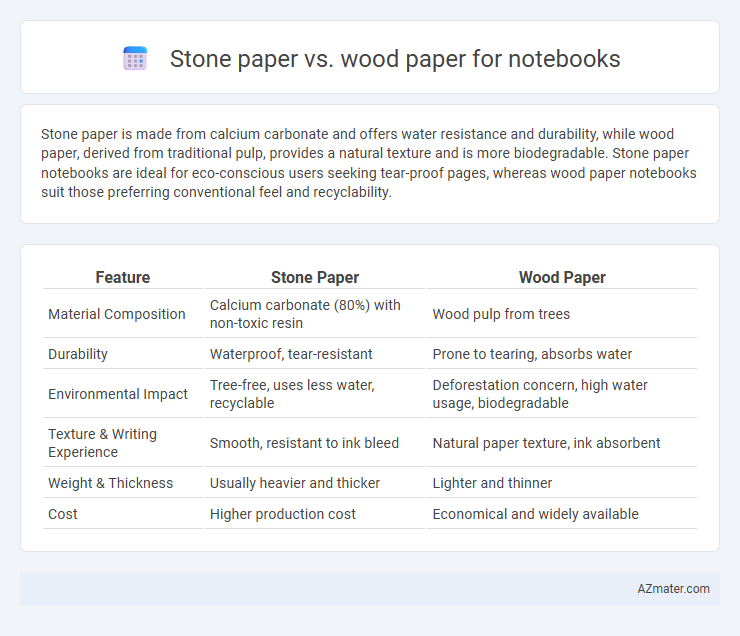Stone paper is made from calcium carbonate and offers water resistance and durability, while wood paper, derived from traditional pulp, provides a natural texture and is more biodegradable. Stone paper notebooks are ideal for eco-conscious users seeking tear-proof pages, whereas wood paper notebooks suit those preferring conventional feel and recyclability.
Table of Comparison
| Feature | Stone Paper | Wood Paper |
|---|---|---|
| Material Composition | Calcium carbonate (80%) with non-toxic resin | Wood pulp from trees |
| Durability | Waterproof, tear-resistant | Prone to tearing, absorbs water |
| Environmental Impact | Tree-free, uses less water, recyclable | Deforestation concern, high water usage, biodegradable |
| Texture & Writing Experience | Smooth, resistant to ink bleed | Natural paper texture, ink absorbent |
| Weight & Thickness | Usually heavier and thicker | Lighter and thinner |
| Cost | Higher production cost | Economical and widely available |
Introduction to Stone Paper and Wood Paper
Stone paper, made from calcium carbonate bonded with non-toxic resin, offers a waterproof, tear-resistant, and eco-friendly alternative to traditional wood paper. Wood paper, derived from cellulose fibers of trees, is biodegradable and widely used but involves deforestation and chemical processing. Comparing the two, stone paper emphasizes durability and sustainability, while wood paper maintains conventional texture and recyclability in notebook production.
Composition and Manufacturing Processes
Stone paper is composed primarily of calcium carbonate bonded with a small percentage of high-density polyethylene (HDPE), creating a waterproof and tear-resistant material produced through a dry process that avoids water and acid usage. In contrast, wood paper is made from cellulose fibers extracted from wood pulp, undergoing a wet manufacturing process involving chemical treatments for bleaching and refining. The stone paper production reduces environmental impact by eliminating trees and water consumption, while wood paper relies on conventional forestry and intensive water use.
Environmental Impact and Sustainability
Stone paper is made from calcium carbonate and requires no trees, reducing deforestation and water consumption compared to traditional wood paper notebooks. Wood paper production involves significant use of water, energy, and chemicals, contributing to habitat destruction and pollution. Stone paper is biodegradable under certain conditions and generates less carbon footprint, making it a more sustainable option for environmentally conscious notebook users.
Durability and Water Resistance
Stone paper outperforms wood paper in durability due to its tear-resistant and non-fibrous composition, making notebooks less prone to damage under heavy use. The water resistance of stone paper is significantly higher, as it is naturally waterproof and does not absorb moisture, preventing pages from warping or smudging. In contrast, wood paper is prone to tearing and water damage, requiring coatings or treatments to improve longevity and moisture protection.
Writing Experience and Texture
Stone paper offers a smooth, almost silky texture that enhances the writing experience by reducing ink bleed and providing a consistent surface for various pen types, unlike traditional wood paper which can feel rougher and more absorbent. The non-porous nature of stone paper allows for quicker drying times and less smudging, making it ideal for fountain pens, gel pens, and markers. Wood paper tends to absorb ink, leading to potential feathering and texture variability, impacting overall writing clarity and tactile feedback.
Print Quality and Ink Compatibility
Stone paper offers superior print quality for notebooks due to its smooth, non-porous surface that allows ink to sit on top without bleeding or feathering, resulting in sharper and more vibrant images and text. Wood paper, commonly made from cellulose fibers, tends to absorb ink, which can cause slight smudging or blurring, especially with certain ink types like gel or fountain pens. Ink compatibility on stone paper is high with most water-based inks, while oil-based inks may take longer to dry, contrasting with wood paper that generally supports a wider variety of inks but lacks the same clarity and detail in print quality.
Weight and Portability
Stone paper is significantly lighter than traditional wood paper, with a typical weight of around 80-100 gsm compared to wood paper's 90-120 gsm, enhancing notebook portability. Its tear-resistant and water-resistant properties allow for a more durable and flexible notebook, reducing bulk and making it easier to carry. This lightweight and robust nature makes stone paper notebooks an ideal choice for students and professionals seeking portable and eco-friendly stationary alternatives.
Cost Comparison: Stone Paper vs Wood Paper
Stone paper notebooks generally have a higher upfront cost compared to traditional wood paper notebooks due to the specialized manufacturing process involving calcium carbonate and resin. Wood paper production benefits from established, large-scale forestry and pulping industries, resulting in lower material and production expenses. Over time, stone paper's durability and waterproof properties may reduce replacement frequency, potentially balancing overall cost despite its initial premium price.
Recycling and Biodegradability
Stone paper is made from calcium carbonate bonded with non-toxic resin, making it waterproof and highly durable but not biodegradable; however, it is recyclable through specialized processes that separate the resin from minerals. Wood paper, derived from cellulose fibers, is biodegradable and compostable, breaking down naturally in the environment and widely accepted in traditional recycling streams. Despite stone paper's resistance to water and tearing, wood paper remains more eco-friendly in terms of end-of-life biodegradability and widespread recyclability for notebooks.
Choosing the Right Paper for Your Notebook
Stone paper offers superior durability and water resistance compared to traditional wood paper, making it ideal for notebooks subjected to rough handling or frequent outdoor use. Wood paper, derived from sustainably managed forests, provides a more natural texture and is often preferred for writing comfort and ink absorption. Choosing the right paper depends on your specific needs: prioritize stone paper for longevity and eco-friendliness due to its plastic-free composition, or select wood paper for traditional feel and biodegradability.

Infographic: Stone paper vs Wood paper for Notebook
 azmater.com
azmater.com